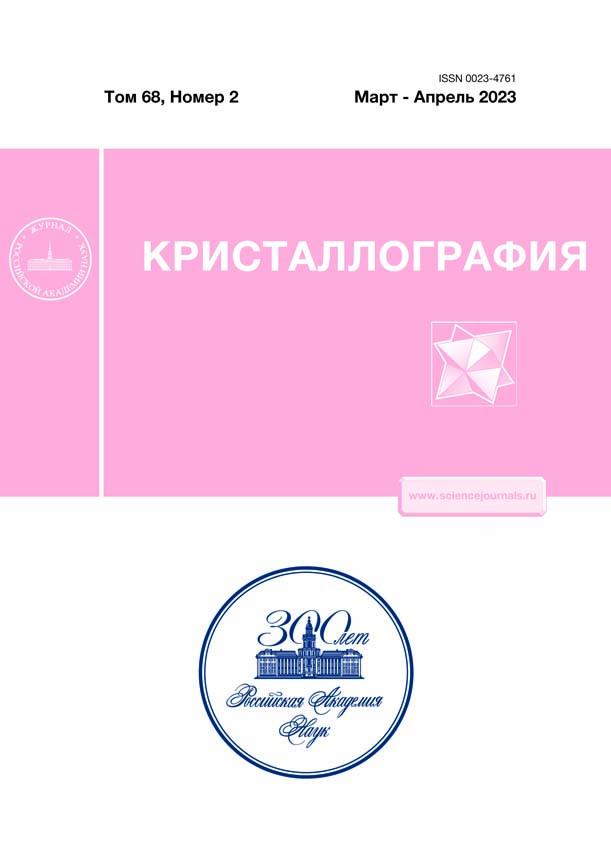LUMINESCENCE OF TWO-DIMENSIONAL ZnO NANOSTRUCTURES: NANOWALLS, NANOSHEETS, NANOCOMBS
- Autores: Tarasov A.P.1, Zadorozhnaya L.A.1, Nabatov B.V.1, Volchkov I.S.1, Kanevsky V.M.1
-
Afiliações:
- Shubnikov Institute of Crystallography, Federal Scientific Research Centre “Crystallography and Photonics,” Russian Academy of Sciences, Moscow, 119333 Russia
- Edição: Volume 68, Nº 2 (2023)
- Páginas: 281-284
- Seção: ФИЗИЧЕСКИЕ СВОЙСТВА КРИСТАЛЛОВ
- URL: https://rjdentistry.com/0023-4761/article/view/673510
- DOI: https://doi.org/10.31857/S0023476123020194
- EDN: https://elibrary.ru/BSVZEO
- ID: 673510
Citar
Texto integral
Resumo
Preliminary comparative studies of the photoluminescent properties of two-dimensional ZnO nanostructures with morphology of nanowalls, nanosheets, and nanocombs, fabricated by gas-transport synthesis, have been performed. All structures exhibited near-band-edge (NBE) UV emission of the same order of intensity. Unlike nanocombs, whose spectrum contains a comparatively strong green luminescence band, nanowalls and nanosheets are characterized by a large ratio of the UV and visible components. This distinction is presumably due to the difference in the mechanisms of structure formation: nanowalls and nanosheets are formed according to the vapor–liquid–solid mechanism, whereas nanocombs grow according to the vapor–solid mechanism
Palavras-chave
Sobre autores
A. Tarasov
Shubnikov Institute of Crystallography, Federal Scientific Research Centre “Crystallography and Photonics,” Russian Academy of Sciences, Moscow, 119333 Russia
Email: tarasov.a@crys.ras.ru
Россия, Москва
L. Zadorozhnaya
Shubnikov Institute of Crystallography, Federal Scientific Research Centre “Crystallography and Photonics,” Russian Academy of Sciences, Moscow, 119333 Russia
Email: tarasov.a@crys.ras.ru
Россия, Москва
B. Nabatov
Shubnikov Institute of Crystallography, Federal Scientific Research Centre “Crystallography and Photonics,” Russian Academy of Sciences, Moscow, 119333 Russia
Email: tarasov.a@crys.ras.ru
Россия, Москва
I. Volchkov
Shubnikov Institute of Crystallography, Federal Scientific Research Centre “Crystallography and Photonics,” Russian Academy of Sciences, Moscow, 119333 Russia
Email: tarasov.a@crys.ras.ru
Россия, Москва
V. Kanevsky
Shubnikov Institute of Crystallography, Federal Scientific Research Centre “Crystallography and Photonics,” Russian Academy of Sciences, Moscow, 119333 Russia
Autor responsável pela correspondência
Email: tarasov.a@crys.ras.ru
Россия, Москва
Bibliografia
- Leonardi S.G. // Chemosensors. 2017. V. 5 (2). P. 17. https://doi.org/10.3390/chemosensors5020017
- Pellegrino D., Franzò G., Strano V. et al. // Chemosensors. 2019. V. 7 (2). P. 18. https://doi.org/10.3390/chemosensors7020018
- Verma A., Chaudhary P., Tripathi R.K., Yadav B.C. // Sens. Actuators A: Phys. 2021. V. 321. P. 112600. https://doi.org/10.1016/j.sna.2021.112600
- Ополченцев А.М., Задорожная Л.А., Брискина Ч.М. и др. // Оптика и спектроскопия. 2018. Т. 125. С. 501. https://doi.org/10.21883/OS.2018.10.46702.142-18
- Tarasov A.P., Briskina Ch.M., Markushev V.M. et al. // Opt. Mater. 2020. V. 102. P. 109823. https://doi.org/10.1016/j.optmat.2020.109823
- Xie J.Q., Dong J.W., Osinsky A. et al. // MRS Online Proceedings Library. 2005. V. 891. P. 1001. https://doi.org/10.1557/proc-0891-ee10-01
- Muslimov A.E., Tarasov A.P., Kanevsky V.M. // Materials. 2022. V. 15. P. 6409. https://doi.org/10.3390/ma15186409
- Тарасов А.П., Задорожная Л.А., Муслимов А.Э. и др. // Письма в ЖЭТФ. 2021. Т. 114. С. 596. https://doi.org/10.31857/S1234567821210035
- Тарасов А.П., Набатов Б.В., Задорожная Л.А. и др. // Кристаллография. 2022. Т. 67. № 6. С. 943. https://doi.org/10.31857/S0023476122060261
- Čížek J., Valenta J., Hruška P. et al. // Appl. Phys. Lett. 2015. V. 106 (25). P. 251902. https://doi.org/10.1063/1.4922944
- Bandopadhyay K., Mitra J. // RSC Adv. 2015. V. 5 (30). P. 23540. https://doi.org/10.1039/C5RA00355E
- Редькин А.Н., Маковей З.И., Грузинцев А.Н. и др. // Неорган. материалы. 2007. Т. 43. С. 301.
- Редькин А.Н., Маковей З.И., Грузинцев А.Н. и др. // Неорган. материалы. 2009. Т. 45. Вып. 11. С. 1330.
- Kim H.J., Sung K., An K.S. et al. // J. Mater. Chem. 2004. V. 14. P. 3396. https://doi.org/10.1039/B409890K
- Тарасов А.П., Веневцев И.Д., Муслимов А.Э. и др. // Квантовая электроника. 2021. Т. 51. С. 366.
Arquivos suplementares












